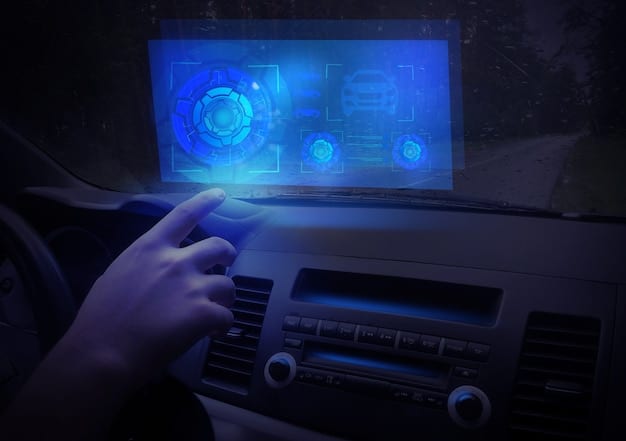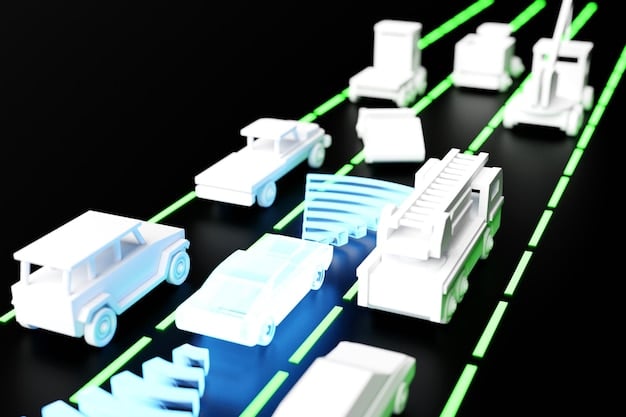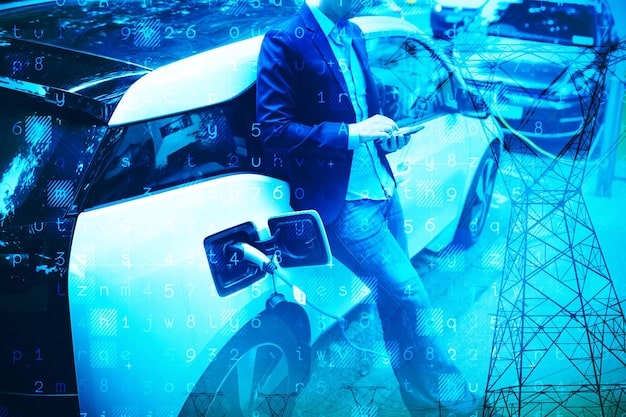The Software-Defined Vehicle Revolution: Reshaping Car Ownership by 2030

What does the rise of software-defined vehicles mean for car ownership in the next 5 years?
Software-defined vehicles (SDVs) are transforming car ownership by enabling continuous updates, personalized experiences, and new business models, potentially shifting the emphasis from vehicle as hardware to vehicle as a service.
The automotive industry is undergoing a seismic shift thanks to the rise of software-defined vehicles. These vehicles are not just transportation; they are becoming sophisticated platforms where software dictates functionality, performance, and user experience. But how will this transformation reshape car ownership in the next 5 years?
Understanding Software-Defined Vehicles (SDVs)
Software-defined vehicles represent a significant departure from traditional automotive engineering. Instead of relying primarily on mechanical components and hardware, SDVs prioritize software and electronic control units (ECUs) to manage vehicle functions. This shift enables greater flexibility, customization, and over-the-air (OTA) updates, paving the way for continuous improvement and new features throughout the vehicle’s lifecycle.
Key Characteristics of SDVs
SDVs are characterized by several key attributes that differentiate them from conventional vehicles. These include advanced sensor integration, powerful computing platforms, and robust connectivity capabilities.
- Centralized Computing: SDVs consolidate various vehicle functions onto a centralized computing platform, reducing the need for numerous ECUs and simplifying software management.
- Over-the-Air (OTA) Updates: SDVs can receive software updates wirelessly, enabling automakers to fix bugs, improve performance, and add new features without requiring physical visits to a service center.
- Advanced Driver-Assistance Systems (ADAS): SDVs leverage sophisticated sensors and algorithms to provide advanced safety features such as adaptive cruise control, lane keeping assist, and automatic emergency braking.

The shift towards software-centric design allows for continuous enhancement and personalization, fundamentally altering the traditional car ownership model. With SDVs, vehicles can evolve and adapt to changing user needs and preferences over time.
The Evolving Car Ownership Experience
The rise of SDVs is poised to revolutionize the car ownership experience in several key ways. From personalized features and enhanced safety to new revenue streams and business models, SDVs are reshaping how consumers interact with their vehicles.
Personalization and Customization
SDVs enable a level of personalization and customization previously unattainable in the automotive industry. Drivers can tailor their vehicle’s settings, features, and interfaces to match their individual preferences and needs.
- User Profiles: SDVs can store multiple user profiles, each with unique settings for seat position, climate control, infotainment preferences, and driving modes.
- App Integration: SDVs can seamlessly integrate with third-party apps and services, allowing drivers to access their favorite content, navigation tools, and productivity apps from the vehicle’s infotainment system.
- Customizable Interfaces: SDVs can offer customizable instrument panels, head-up displays, and infotainment screens, allowing drivers to prioritize the information that matters most to them.
This level of personalization not only enhances the driving experience but also fosters a deeper connection between drivers and their vehicles. SDVs can learn and adapt to individual driving habits, providing a more intuitive and enjoyable experience.
New Business Models Enabled by SDVs
SDVs are not only transforming the car ownership experience; they are also unlocking new business models and revenue streams for automakers and service providers. Software-defined architectures enable a variety of innovative services, including subscription-based features, on-demand upgrades, and data-driven insights.
Subscription-Based Services
One of the most significant changes brought about by SDVs is the rise of subscription-based services. Automakers can offer optional features and functionalities on a subscription basis, allowing drivers to access advanced capabilities without incurring the upfront cost of purchasing them outright.
- Advanced Driver-Assistance Systems (ADAS): Drivers can subscribe to advanced ADAS features such as adaptive cruise control, lane keeping assist, and automatic parking, paying only for the features they use.
- Performance Upgrades: SDVs can offer performance upgrades on a subscription basis, allowing drivers to temporarily unlock additional horsepower, torque, or acceleration.
- Entertainment and Connectivity: Drivers can subscribe to premium entertainment and connectivity services, such as streaming music, video, and high-speed internet access.
These subscription models provide automakers with recurring revenue streams while offering drivers greater flexibility and control over their vehicle’s features.
Challenges and Opportunities in the SDV Era
While the rise of SDVs presents numerous opportunities for automakers and consumers, it also poses significant challenges. These include cybersecurity risks, regulatory hurdles, and the need for new skills and expertise.
Cybersecurity Risks
As vehicles become increasingly software-defined, they become more vulnerable to cybersecurity threats. Hackers could potentially exploit vulnerabilities in the vehicle’s software to gain unauthorized access, steal data, or even control critical vehicle functions.

To mitigate these risks, automakers must invest in robust cybersecurity measures, including encryption, intrusion detection systems, and regular security updates. They must also work closely with cybersecurity experts and researchers to identify and address potential vulnerabilities.
Regulatory Hurdles
The rapid pace of innovation in the SDV space is outpacing existing regulations, creating uncertainty and potential barriers to adoption. Regulators must develop new frameworks and standards to address the unique challenges posed by SDVs, including data privacy, safety, and cybersecurity.
The Role of Data in SDV Development
Data plays a crucial role in the development, deployment, and operation of SDVs. Vehicles generate vast amounts of data related to driving behavior, vehicle performance, and environmental conditions. This data can be used to improve vehicle safety, enhance user experiences, and optimize vehicle performance.
Data Collection and Analysis
SDVs are equipped with numerous sensors and data collection devices that continuously monitor vehicle parameters and environmental conditions. This data is transmitted to the cloud, where it is analyzed to identify trends, patterns, and anomalies.
- Driving Behavior: SDVs can collect data on driving behavior, such as speed, acceleration, braking, and steering inputs. This data can be used to personalize driving modes, optimize fuel efficiency, and improve safety.
- Vehicle Performance: SDVs can monitor vehicle performance metrics such as engine temperature, oil pressure, and battery health. This data can be used to predict maintenance needs, optimize vehicle performance, and prevent breakdowns.
- Environmental Conditions: SDVs can collect data on environmental conditions such as weather, road conditions, and traffic patterns. This data can be used to improve navigation, optimize routing, and enhance safety.
The insights derived from this data can be used to improve vehicle design, optimize performance, and develop new features and services.
Preparing for the Future of Car Ownership
As SDVs become more prevalent, consumers, automakers, and policymakers must prepare for the future of car ownership. This includes investing in new skills and expertise, addressing regulatory challenges, and embracing new business models.
Embracing New Technologies
To fully realize the benefits of SDVs, consumers must be willing to embrace new technologies and adapt to new ways of interacting with their vehicles. This includes becoming familiar with software updates, subscription-based services, and data-driven features.
By embracing new technologies and adapting to new ways of interacting with their vehicles, consumers can unlock the full potential of SDVs and enjoy a more connected, personalized, and enjoyable driving experience. Ultimately, the rise of software-defined vehicles could lead to a world where car ownership focuses less on hardware and more on access to ever-evolving services.
| Key Point | Brief Description |
|---|---|
| ⚙️ OTA Updates | Software updates improve performance and add new features without needing a service visit. |
| 💰 Subscription Services | Access advanced features like ADAS or performance upgrades through subscriptions. |
| 🔒 Cybersecurity Risks | Software vulnerabilities create cybersecurity threats that need robust protective measures. |
| 📊 Data-Driven Insights | Vehicle data improves safety, enhances user experiences, and optimizes vehicle performance. |
Frequently Asked Questions (FAQ)
▼
An SDV prioritizes software to control vehicle functions, offering greater flexibility and customization than traditional cars. It centrally manages functions and allows over-the-air updates.
▼
OTA updates are wireless software updates that can fix bugs, improve performance, and add new features to the vehicle without requiring a visit to a service center.
▼
Examples include subscriptions for advanced driver-assistance systems (ADAS), performance upgrades (like unlocking horsepower), and premium entertainment and connectivity services.
▼
SDVs are vulnerable to hacking, which can lead to unauthorized access, data theft, or even control of vehicle functions. Automakers must invest in robust cybersecurity measures.
▼
Data collected from SDVs provides insights into driving behavior, vehicle performance, and environmental conditions. This helps improve safety, enhance user experiences, and optimize vehicle performance.
Conclusion
The rise of software-defined vehicles marks a pivotal moment in automotive history, promising a future where cars are constantly evolving, highly personalized, and deeply integrated into our digital lives. While challenges remain in areas like cybersecurity and regulation, the potential benefits—from enhanced safety and convenience to new business models and revenue streams—are undeniable, suggesting a bold shift in car ownership over the next five years.





